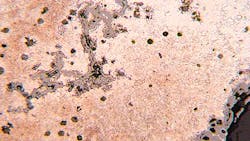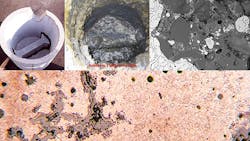Reducing Slag and Dross in Ductile Iron Castings
On the other hand, dross is the byproduct of the magnesium treatment. Magnesium loves oxygen, and when introduced to cast iron the magnesium oxide compound (MgO) is formed. MgO is formed during the treatment, but it continues to be formed during the subsequent handling of metal. In addition to sound foundry practices, as mentioned above, there are additives that can be added to the ductile iron to reduce slag and dross defects. DISPERSIT™ is a metallurgical product that, when added to ductile iron, significantly reduces those time- and cost-consuming defects.
Q:Will using When and how much DISPERSIT should be added to ductile iron? A: It’s best to add DISPERSIT to the treatment ladle between the MgFeSi alloy and the cover material. The product comes prepackaged in 0.5-kg (1.1-lbs.) bags. The sizing is very fine (0 – 1.6 mm), and can be hydroscopic. Therefore, it is recommended that the product be used as supplied, in the prepackaged bags. An addition rate of 0.1-0.2% is recommended for most ductile iron shops.Q:Will using DISPERSIT mean that most of the slag and dross in the melt will float to the surface, making it easier to remove during de-slagging?A:DISPERSIT will reduce the surface tension, expediting the release of the MgO into the atmosphere. The small addition of DISPERSIT will refine and disperse the slag making the de-slagging practice more effective. Q:During ductile production there is severe buildup in the tundish and pouring ladles. Will DISPERSIT address this problem?A:DISPERSIT will significantly reduce buildup of slag material in the ladles, typically doubling the service life of the treatment and pouring vessels. As you may know, magnesium recovery is best when the ladles are clean, so keeping the treatment ladle clean will reduce a foundry’s alloy cost.Q:Are there other benefits to ductile iron?A:Besides those already stated, it should be mentioned that DISPERSIT will help to improve the fluidity of the iron thanks to the reduction in surface tension. Reduced surface tension permits pouring of thin-rangy castings at lower temperatures, avoiding mis-runs and cold laps.Q:We also pour gray iron: is it possible to use the same product such alloys, and have the same effects? A:Yes. DISPERSIT can be used to control slag defects in gray iron, too. We have experience at several foundries that have successfully used this product with gray iron. Of course, in these cases we have to work only about slag. Even if gray iron is not as dirty as ductile, slag is a considerable concern. For this reason, it is important to minimize slag in gray iron too, and DISPERSIT definitely helps to achieve this.For gray iron, it is recommended that DISPERSIT should be introduced at the inoculation step; The recommended addition rates (0.1 – 0.2% by weight) remain the same. Keep in mind that good slagging practices should be employed always.
Join the Conversation. Email Your Questions for ASK Chemicals
Share your insights, opinions, and elaborate on the questions and the experts' answer(s). You must be logged in to the website in order to post your comments.

